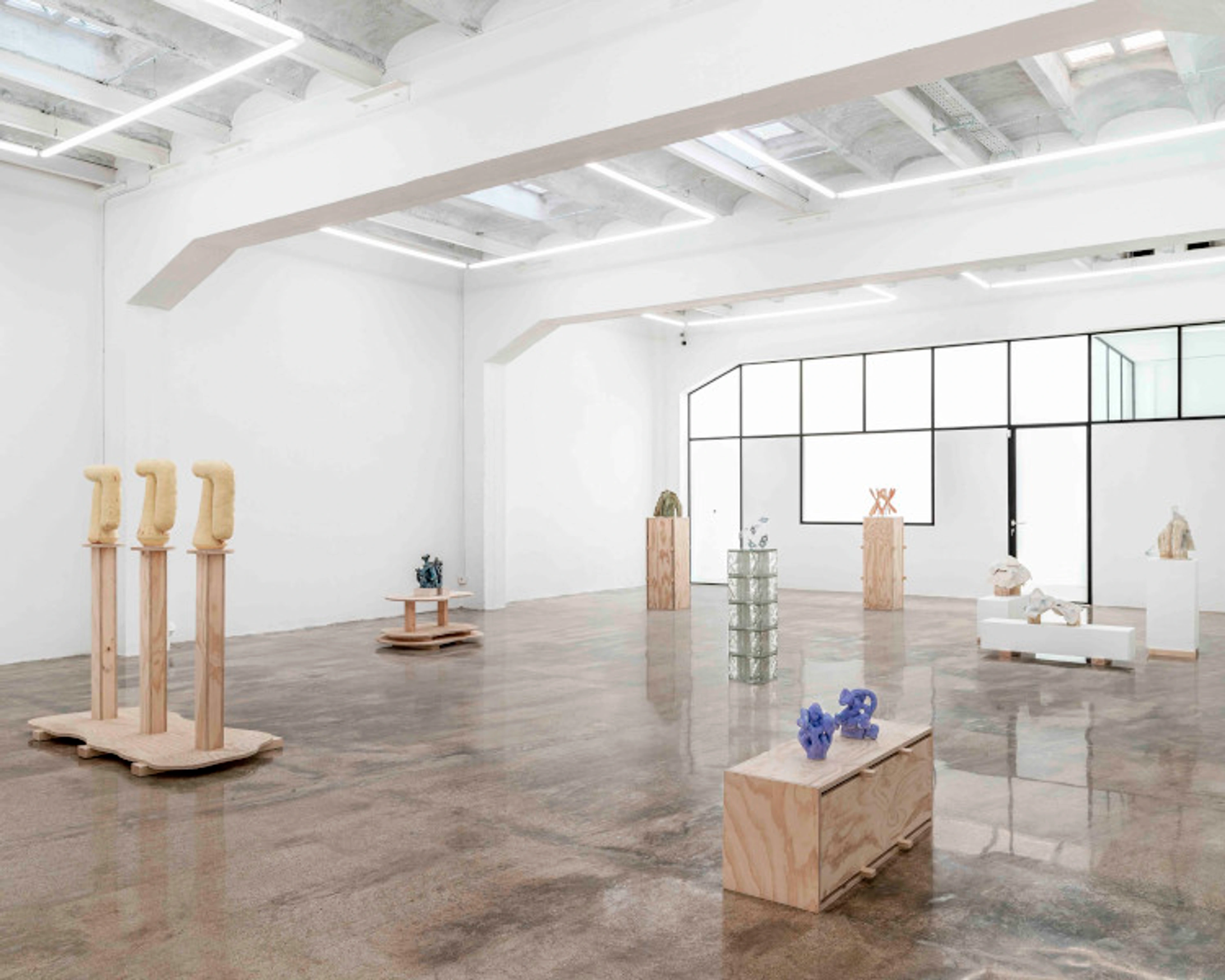
Crafting a Cohesive Art Collection: Weaving Your Home's Unique Story
Unlock the secret to a harmonious home. My personal guide shows how to blend diverse art, connect rooms with an 'invisible thread' of color, texture, and theme, and tell your unique story.
The Invisible Thread: Weaving a Cohesive Art Collection Across Your Entire Home
You know that feeling when you walk into a beautifully curated space, where everything just... clicks? It’s not about matching; it’s about a subtle, almost invisible thread that pulls the whole narrative together, transforming a house into a truly unified home. For me, that's the magic of a cohesive art collection, especially when it spans different rooms. It's not an easy feat, and honestly, for years I felt like my home was a collection of individual art exhibits rather than a unified story. I mean, who hasn't bought a piece they absolutely loved, only to bring it home and wonder, "Where on earth does this fit?" I certainly have, a stack of "loved, but homeless" canvases gathering dust in the corner is a testament to that. It’s a bit like having a wonderful thought in your head, but struggling to articulate it, leaving a sense of visual chaos – a restless jumble where your eye doesn't know where to rest.
This isn't about turning your home into a sterile gallery. Far from it. It's about letting your art breathe, allowing each piece to shine while contributing to a larger, more beautiful symphony. It’s a bit like orchestrating a conversation where every voice is unique but speaks the same underlying language. Let me share my journey and some thoughts on how to make that happen.
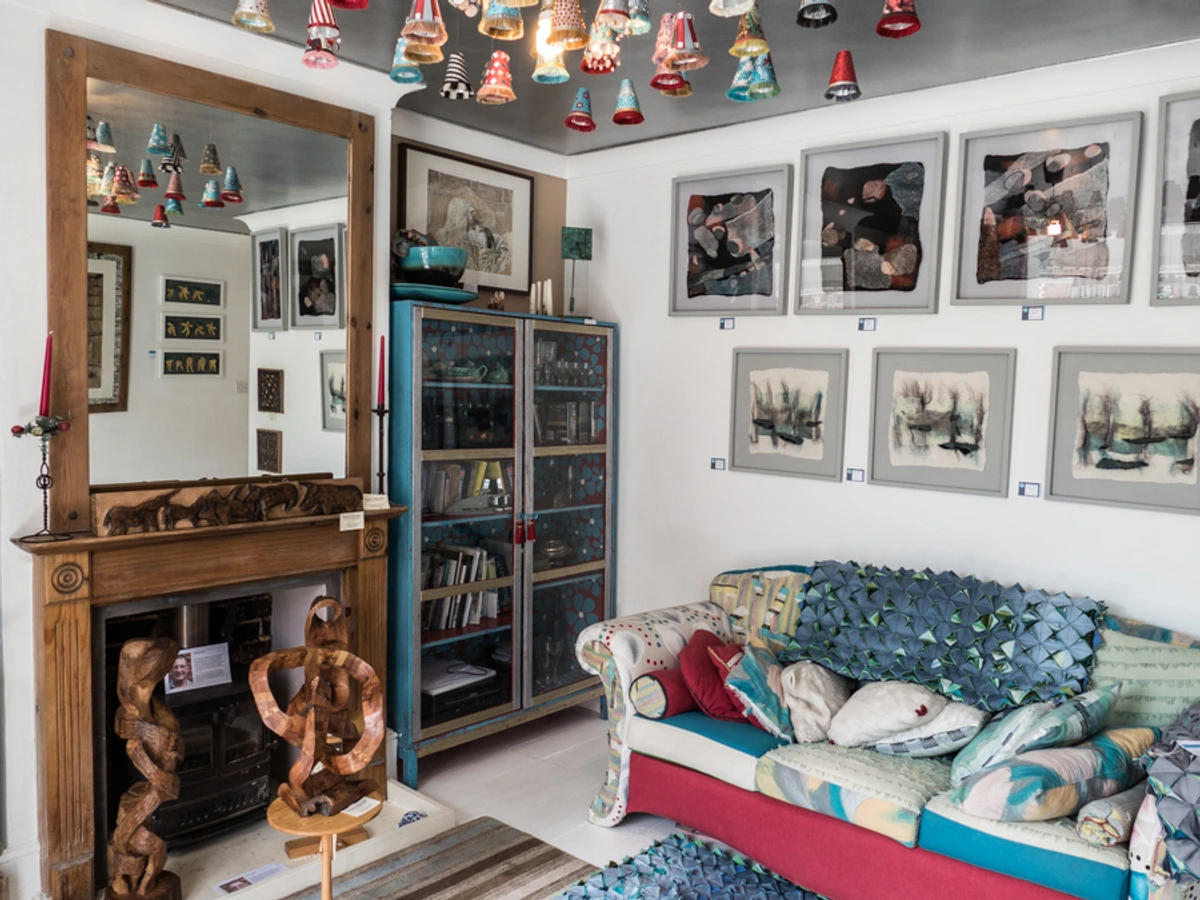
https://www.flickr.com/photos/romseyfestival/35895267135, https://creativecommons.org/licenses/by-nc/2.0/deed.en
Why Cohesion Isn't Just for Curators (And Why I Bother)
I used to think cohesive meant "boring" or "matchy-matchy." My early attempts at decorating were a testament to this misconception – a burst of vibrant abstract here, a serene landscape there, and maybe a quirky pop art print squeezed in between. Each piece wonderful on its own, but together? It was less "eclectic charm" and more "visual cacophony" – a jarring, restless mix of visual elements that fought for attention. It felt restless, like the art was constantly vying for attention instead of settling into a comfortable rhythm. I remember one particularly aggressive red abstract battling a calm blue seascape in my living room; it was exhausting just to look at, and frankly, a bit draining on my mental energy. The constant visual competition felt like an unwelcome guest, subtly contributing to a sense of unease.
What I've learned, both as an artist and as someone who cherishes their living space, is that cohesion brings a profound sense of calm. It invites you to linger, to absorb, and to truly live with your art. It respects the individual personality of each room while still acknowledging that it's all part of one home. Think of it as creating an abstract art flow for every room – a gentle current connecting everything, and surprisingly, bringing a quiet sense of order to my sometimes-chaotic mind. It allows the diverse voices of my collection to harmonize, rather than shout.
My "Invisible Thread" Philosophy: More Than Just Color
So, how do we weave this invisible thread without stifling our individual tastes? For me, it boils down to a few key elements, seen through a very personal lens. It’s less about following strict rules and more about understanding the whispers between pieces, letting instinct guide the dialogue.
1. The Underlying Narrative: What Story Are You Telling?
Every home has a story, or perhaps a collection of smaller stories that intertwine. What's yours? Is it a vibrant, energetic tale of adventure? A calming ode to nature? A minimalist whisper of modern elegance? Or perhaps, like mine, a blend of quiet introspection and bursts of creative energy? When I approach my own collection, or even when I'm creating art for someone else, I think about the overarching feeling I want to evoke, the mood I want to set. For example, a home with a narrative of "urban exploration" might feature abstract pieces with strong geometric lines, gritty textures, and a cool, industrial palette. Conversely, a "forest retreat" narrative might call for organic forms, earthy tones, and fluid brushstrokes. It's about letting your core story subtly inform your choices, connecting what resonates with your space and soul.
Quick exercise: Take 5-10 minutes. Grab a pen and paper and jot down 3-5 words that describe the overall feeling or story you want your home to tell. Is it 'serene and mindful,' 'vibrant and playful,' 'minimalist and contemplative'? Let these words be your compass.
For instance, my studio might have pieces that explore raw, energetic mark-making, reflecting my creative process. But the living room, where I unwind, leans towards calmer, more introspective pieces, even if they share similar color palettes. It's about understanding the unique chapter each room plays in your home's larger story.
2. The Whisper of Color, Not a Shout
This is where many people get stuck, thinking every room needs to match its art precisely. Nope. That’s the road to "boring." Instead, I think about a complementary color story, a "chromatic echo" as I like to call it. This means there's a recurring subtle hint of a specific blue or a warm ochre that appears in different shades, intensities, or textures across various pieces. It’s about creating a visual hum, not a direct repetition. Perhaps a vibrant yellow in one room finds its echo in a muted, mustard tone in another, or cool blues are consistently present, but in varying saturations. Think of analogous colors (next to each other on the color wheel) for gentle transitions, or sparingly used complementary pops for intentional energy.
Consider the emotional language of color. If I use a bold red in an energetic kitchen piece, I might use a muted, earthy red in a more serene bedroom piece, creating a subtle echo rather than a direct copy. It's about finding harmony, not uniformity. You can learn more about my approach to palette and emotion in another article, where I delve into how I craft my own color stories.
3. The Unifying Power of Texture: A Tactile Thread
Often overlooked, texture can be a surprisingly powerful unifying element. Think about the surface quality of your art: is it the tactile richness of thick, impasto paint that catches the light and casts subtle shadows? The sleek, almost liquid surface of glossy resin that reflects light and creates a sense of depth? Or perhaps delicate, layered paper that invites closer inspection? Even if the colors or styles vary, a consistent feel across textures can create a quiet sense of cohesion. For instance, a series of pieces with visible brushstrokes, or conversely, a collection of smooth, almost reflective surfaces, can subtly tie different rooms together. It's a tactile thread that appeals to another sense, a whisper of continuity that the eye (and sometimes the imagination) feels. Imagine an entire home where every piece, regardless of color, boasts a rich, almost sculptural surface – that's a cohesive texture story. For a deeper dive, I explore the role of texture in abstract art elsewhere.
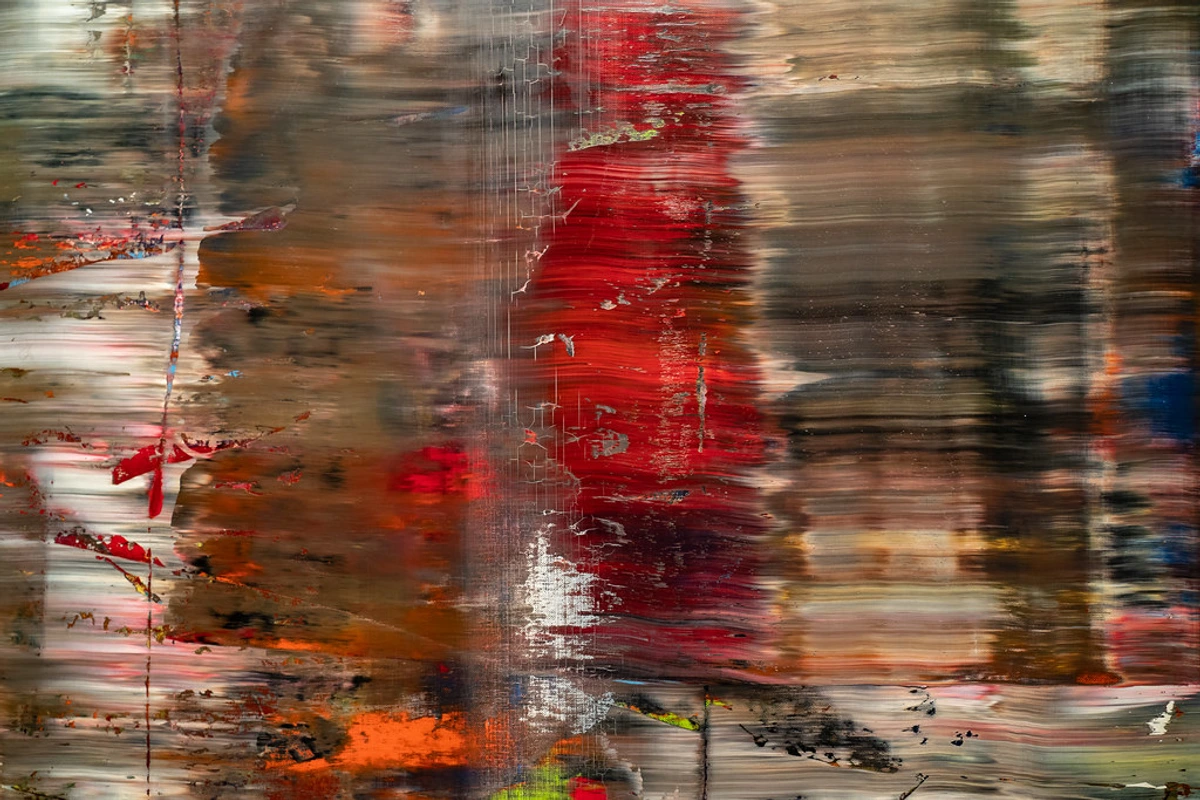
https://live.staticflickr.com/65535/53064827119_1b7c27cd96_b.jpg, https://creativecommons.org/licenses/by-nc-nd/2.0/
4. Thematic Echoes: Beyond the Visible
While color and texture are wonderfully tangible, sometimes the deepest connection comes from a thematic resonance – an unspoken agreement between pieces that speaks to a shared idea, motif, or emotional landscape. This could be a recurring subject matter (even if abstractly rendered, like a consistent exploration of organic forms or geometric patterns), a shared artistic influence, or simply a consistent emotional tone. If all your art, regardless of its visual elements, evokes a sense of calm, or conversely, a vibrant energy, that's a powerful invisible thread. It's about asking: What underlying concepts or feelings do these pieces share? Do they all hint at a certain philosophy or worldview? This creates a rich, intellectual layer of cohesion that truly elevates a collection.
5. Playing with Style and Scale: Finding Common Ground
You absolutely can mix different styles of art! The trick is to find common ground, that unspoken dialogue between seemingly disparate pieces. Perhaps it's a shared abstract quality, a similar minimalist aesthetic, or even just a consistent level of visual complexity. I often find that focusing on the feeling a piece evokes helps more than its strict genre. Two vastly different pieces can speak to each other if they share a certain energy or a deliberate simplicity. Maybe a vibrant, geometric abstract in the living room finds a quiet echo in a delicate, organic abstract in the study through a shared sense of movement, albeit expressed differently. It's about the connection, not identicalness. This relates to what I look for as an artist when I curate my own pieces.
For scale, don't be afraid to go big in some spaces and smaller in others. A dramatic, large-scale abstract piece can anchor an open-concept living area, while a series of smaller, complementary pieces can create an intimate gallery wall in a hallway. It's about finding balance and letting the pieces breathe within their environment, ensuring no single artwork overwhelms its space or its neighbors.
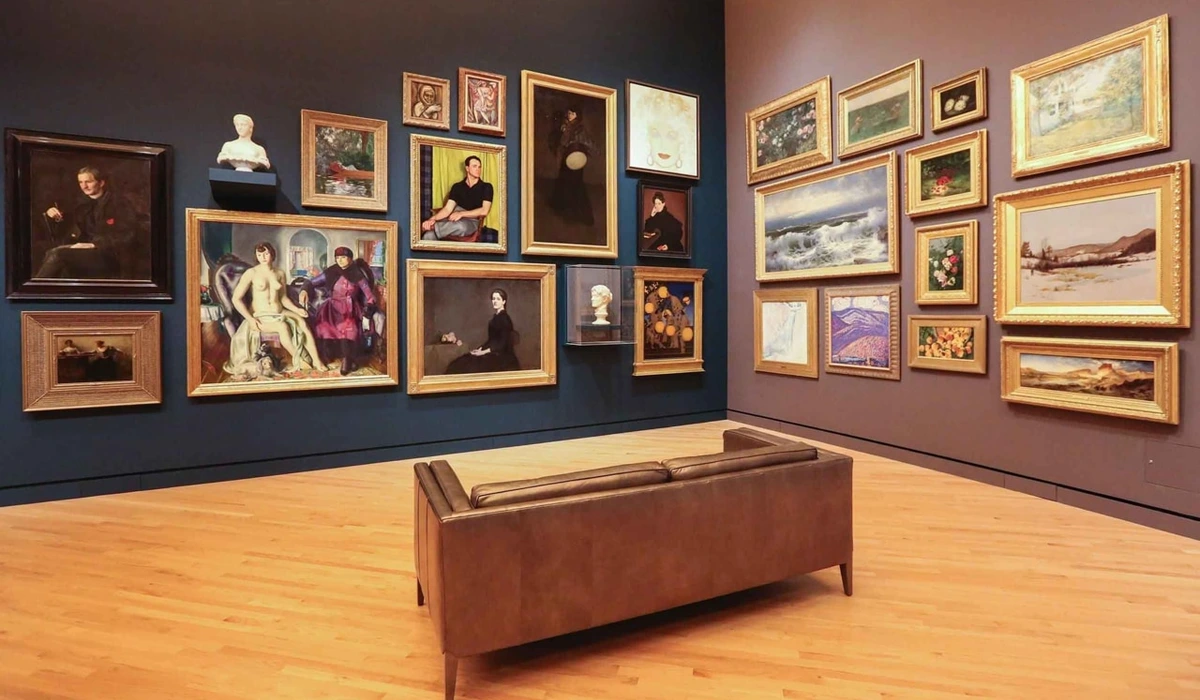
https://mastersatart.com/, https://creativecommons.org/licenses/by-nc/4.0/
6. The Art of Breathing: Negative Space
Just as important as the art itself is the space around it. How much wall is visible between pieces? Is there a consistent amount of "breathing room"? Deliberate use of negative space can create a sense of calm and visual order throughout your home, even with diverse artworks. If every piece is crammed together, it creates visual noise. But giving each artwork its space allows the eye to rest and appreciate the individual piece while also perceiving the overall flow. It’s like the silent pauses in a melody – essential for the music to truly resonate. I delve deeper into this concept in my article on the power of negative space and how I integrate it into my own composition.
Practical Steps: Weaving the Thread Room by Room
Alright, enough philosophy! Sometimes, my mind just runs with these things. Let's get down to brass tacks – the actual doing. Remember, this is your home, your sanctuary, and your story. There are no right or wrong answers, just what feels most you.
Getting Started: The Mindset of a Soulful Decorator
Before diving into specifics, cultivate a mindset of playful curiosity and patience. Creating a cohesive collection is a journey, not a sprint. It's about collecting pieces that resonate deeply with you, and then thoughtfully arranging them. Don't feel pressured to have a "complete" collection immediately. Embrace the evolution, the searching, and the occasional happy accident.
Step 1: The Home Audit (And a Reality Check)
Before you buy a single new piece, take a walk through your home. What do you already have? What do you love, truly? What feels "off" and why? What emotions do different rooms evoke? I like to take photos – it helps me see my space with fresh eyes, almost like a curator examining an exhibition. It also helps me acknowledge where I might have made some... enthusiastic, but ultimately misguided choices in the past. (We all do it, it’s part of the journey! I once bought a sculpture that, upon arrival, bore an uncanny resemblance to a startled garden gnome. It now resides happily in my shed.) As you walk through, ask yourself: Will this new piece join the symphony, or will it create another solo act? What about this current piece isn't working for me?
Step 2: Define Your Core "Vibe" (Or 2-3 Intertwining Vibes)
Is your home generally calm and serene, vibrant and eclectic, or perhaps a blend of thoughtful minimalism and unexpected pops of character? You don't need one word, but a general sense of the overarching feeling. This helps immensely when decorating your home in general. For me, my home is a blend of quiet introspection and bursts of creative energy. I try to make sure my art reflects that, evolving as I do, much like my own journey.
Step 3: Choose Your Connecting Elements
Based on your vibe, what will be your "invisible thread"? It could be one, or a combination of a few, chosen deliberately:
- A Recurring Color Family: Not exact matches, but perhaps a preference for cool tones, or earthy neutrals with pops of warmth. Think of it as a subtle color conversation across rooms, a shared chromatic language that gently guides the eye. Consider how your chosen colors influence the mood of each space, whether it’s a vibrant blue or a calming earthy green.
- A Consistent "Energy" or Mood: Is your art generally peaceful and flowing, or does it always have a dynamic, energetic movement? This emotional consistency is a powerful unifier, guiding the viewer through a consistent emotional landscape. It's about the feeling that permeates your spaces.
- Similar Subject Matter (Abstractly Speaking): If you love abstract landscapes, even if varied, that's a thread. If you love geometric forms, that's another. It’s about a shared thematic interest, a recurring motif that speaks to your soul, providing a subtle narrative backbone.
- Consistent Framing Style: This is often overlooked but incredibly powerful. Simple black, natural wood, or sleek metallic frames can instantly unify diverse pieces, giving your collection a polished, intentional look.
- Texture: A deliberate choice for either predominantly smooth, subtle textures or rich, tactile impasto throughout. This adds a sensory layer of cohesion that the eye (and sometimes the imagination) intuitively connects.
- Negative Space Philosophy: A conscious decision about how much breathing room you give each piece, creating visual calm and allowing each artwork to be seen and appreciated without competing.
Step 4: Room-Specific Adjustments
Now, apply that thread to each room while considering its unique function and existing decor. Each room is a chapter; make sure its art serves its purpose within the larger narrative.
- Living Room: Often the heart of the home, this is where you can make a statement. I might feature a large abstract piece that hints at my core color story, inviting quiet contemplation or lively discussion. It's a space for connection and shared experience, so the art should facilitate that.
- Dining Room: A place for conversation and connection. Perhaps pieces that are stimulating but not overpowering, encouraging dialogue and a sense of shared experience without dominating the atmosphere. Think engaging rather than demanding.
- Bedroom: Serenity is key. Softer palettes, fluid lines, something that encourages calm and introspection – a visual lullaby. This is where the emotional consistency of peaceful energy truly shines.
- Hallways/Entryways: These are transitional spaces, perfect for carrying the thread gently. A small collection of related pieces or even just a consistent framing style can work wonders, acting as visual breadcrumbs guiding you through your home, offering glimpses of the larger story.
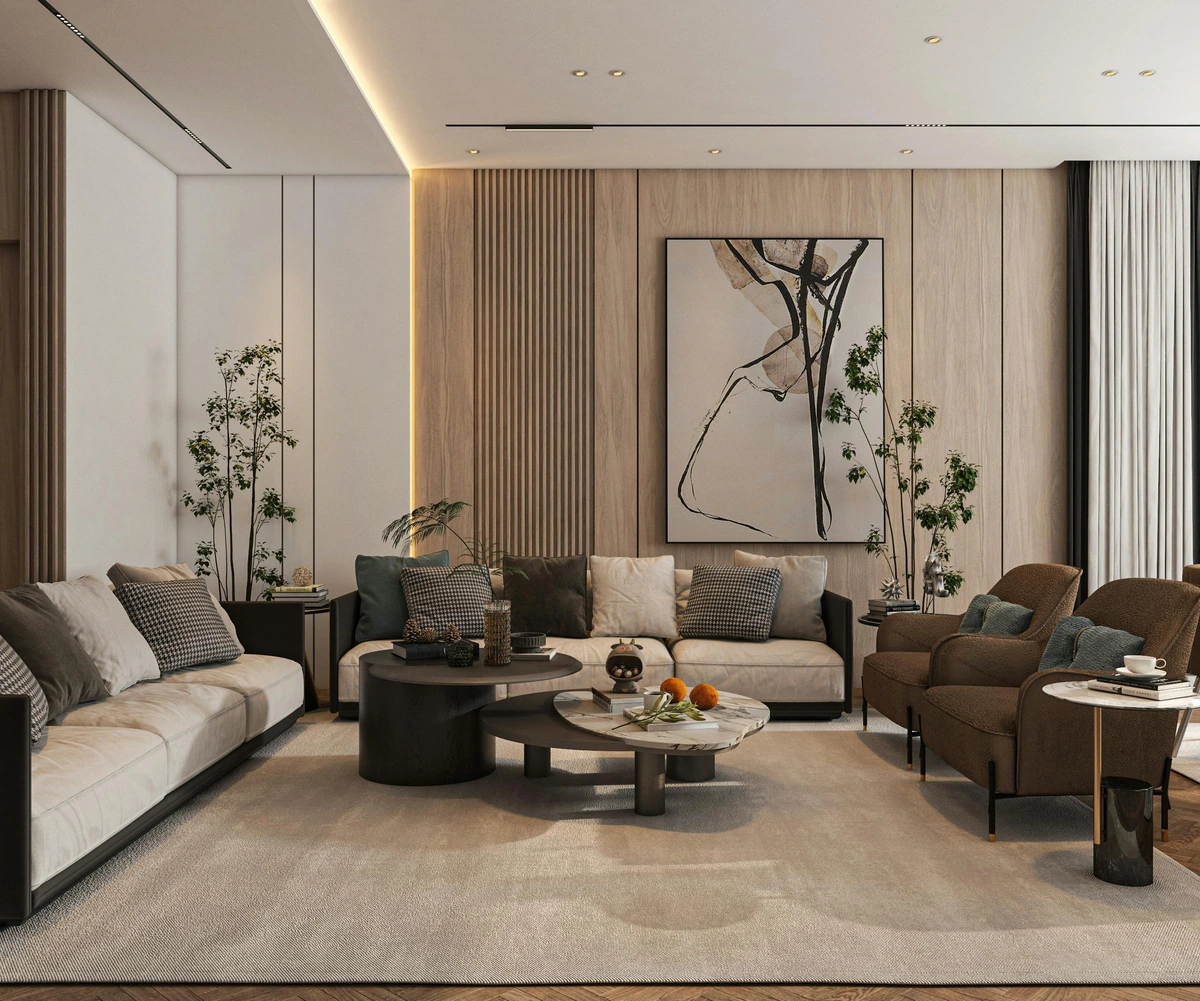
https://www.pexels.com/photo/modern-design-of-living-room-in-house-20035976/, https://creativecommons.org/public-domain/
Beyond the Brushstroke: Other Unifiers
Lighting: The Silent Curator
Just like in a museum, how you light your art profoundly impacts its presence and its relationship to other pieces. Consistent lighting temperatures (warm or cool) throughout your home, or a strategic use of accent lighting on key pieces, can unify diverse artworks. A piece that feels stark under cool light might soften and blend beautifully under a warmer glow, creating a cohesive visual experience across rooms. Consider how lighting and positioning affect perception – it’s a powerful tool in your curation arsenal.
The Evolving Collection: Art as a Reflection of Growth
Your home and your soul are not static. Your art collection shouldn't be either. It’s okay for your taste to evolve, for new pieces to enter your life and old ones to find new homes. The trick is to allow this evolution to happen while still being mindful of your invisible thread. Perhaps the thread itself subtly shifts over time, reflecting your journey of personal growth and artistic discovery. It’s a beautiful dance between stability and change, allowing your home to truly reflect who you are at any given moment.
My Cohesion "Cheat Sheet": Quick Reference for the Soulful Decorator
Element | How I Think About It (And You Could Too!) |
|---|---|
| Color | Not matching, but harmonizing. Think analogous (next to each other on the color wheel) or complementary (opposite) pops. A subtle repeat of a shade, or the overall warm/cool temperature. My palette and emotion are intertwined, and so are yours. |
| Theme/Feeling | Is there a recurring emotion (calm, energetic, meditative)? A concept (nature, urban, spiritual)? This is often the strongest invisible thread. It's about what you want your home to feel like, and how your art supports that. |
| Style | While you can mix, look for a shared sensibility. Perhaps it's all contemporary, or all leans towards abstraction. Even if styles differ, a consistent level of visual "busyness" or "simplicity" can create flow, guiding the eye through a cohesive composition. This relates to what I look for as an artist. |
| Scale & Placement | Vary piece sizes, but ensure balance. A huge piece doesn't need to be in every room; sometimes a thoughtfully arranged cluster of smaller pieces makes a bigger impact. Consider how lighting and positioning affect perception. |
| Texture | A tactile conversation! Are your pieces generally smooth, or do they have rich, varied surfaces? Consistent texture (or intentional, harmonious contrasts) can unify a space on a deeper, sensory level. |
| Negative Space | The quiet hero. How much breathing room do you give your art? Consistent spacing creates visual calm and allows individual pieces to sing without yelling over each other. It's the silent glue. |
| Framing | The unsung hero of cohesion! Consistent frames (material, color, thickness) tie disparate pieces together beautifully. It’s like giving all your art a uniform, making them feel like a team. I personally lean towards simple frames that don't compete with the art, allowing the composition to guide the eye. |
| Personal Connection | At the end of the day, if you truly love a piece, you'll find a way to make it work. Your art collection is a reflection of you, your journey, your tastes. Don't sacrifice love for rigid rules. This is why I paint abstract – to connect on a deeper, more personal level. |
Don't Forget the Emotional Connection (It's Your Home, After All!)
My biggest piece of advice, and something I tell myself constantly, is that your home is your sanctuary. The art you choose should bring you joy, peace, or provoke thought in a positive way. Don't get so caught up in "rules" that you lose the emotional connection. If a piece speaks to your soul, even if it's a bit of an outlier, make space for it. It's those unique pieces that often become conversation starters and truly make a house a home, making your art inspiration truly shine. Remember, art is a dialogue between the creator, the piece, and you. Your intuition is your most valuable curatorial tool.
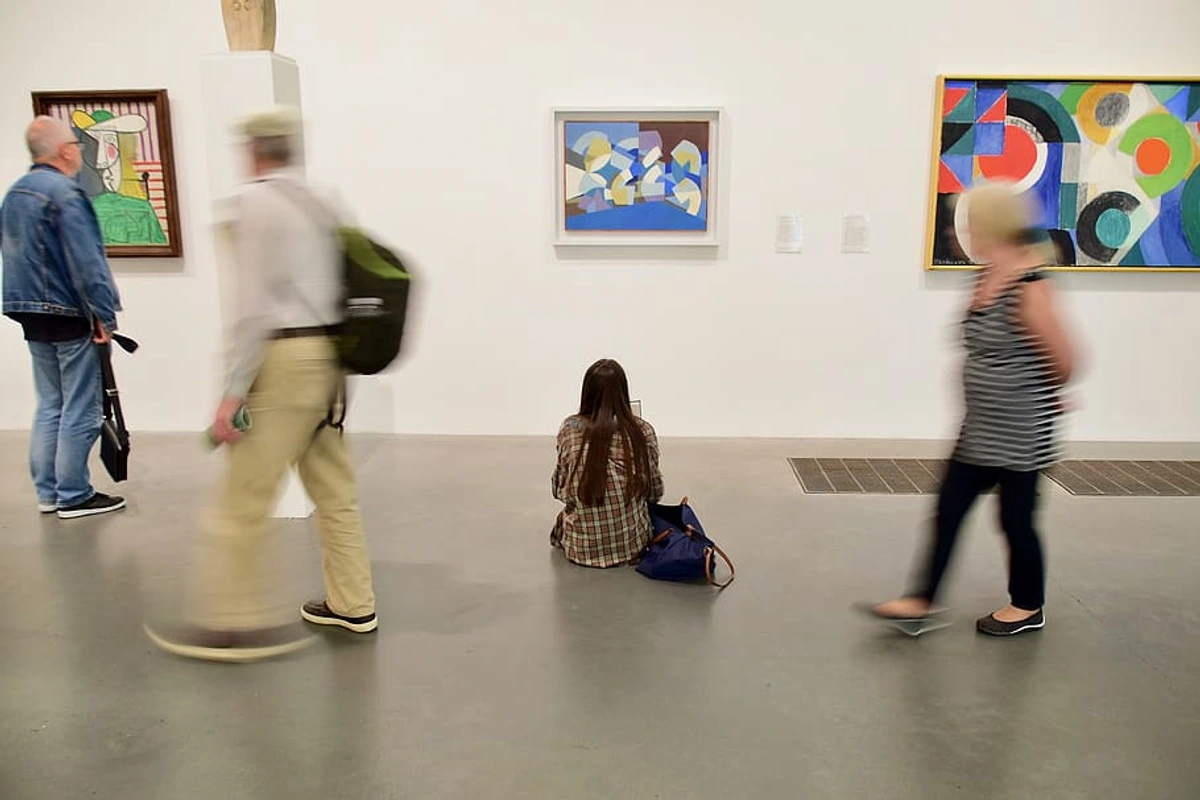
https://www.pxbarn.com/en/search?q=art+gallery, https://creativecommons.org/licenses/publicdomain/
If you're looking for that special piece that resonates, something that could be the next thread in your home's story, feel free to explore my current collection. Each piece is a piece of my heart, hoping to find its way into yours.
When in Doubt, Visit a Museum (Or My Studio!)
Sometimes, the best way to understand cohesion is to see it in action. Visit a local art gallery or museum. Notice how curators arrange diverse collections, how they create flow between rooms, and how the overall narrative unfolds. Pay attention to how seemingly disparate works are brought into dialogue through thoughtful placement, lighting, or thematic grouping. It’s a masterclass in visual storytelling. You might even find yourself inspired to visit my own museum in 's-Hertogenbosch, where I've had the immense privilege of seeing my work displayed in a curated setting – a truly humbling experience to see your own stories woven into a larger narrative.
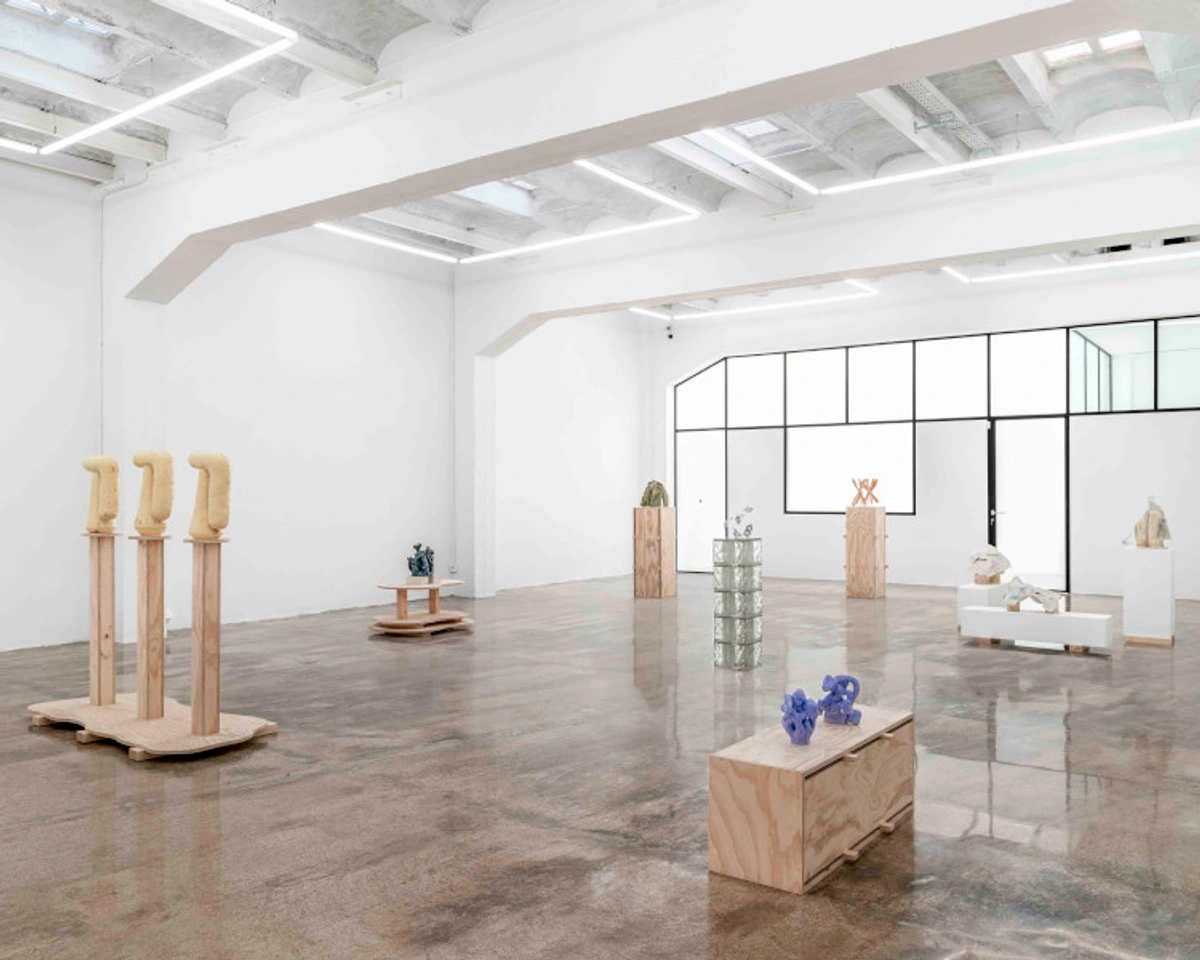
https://www.widewalls.ch/magazine/antoni-ferrer-interview, https://creativecommons.org/licenses/by/4.0/
Common Pitfalls to Avoid: A Quick, Self-Aware List
I’ve made these mistakes, so you don’t have to (or at least, you can laugh knowingly when you do):
- Impulse Buying Without The Bigger Picture: That little abstract piece might be perfect, but will it play nice with everyone else? Sometimes, it's best to take a photo of your intended space before committing, or at least mentally envision its new companions. Before you commit, ask yourself: Does this piece truly resonate with my home's overarching narrative? Will it join the existing symphony, or create a jarring solo performance? It's okay to wait for the right piece.
- Over-Matching: Don't force everything to be the exact same color or style. That’s how sterile, uninspired spaces are born. Subtlety is your friend; harmony, not uniformity, is the goal. Your home isn't a showroom; it's a living, breathing expression of you. Think variations on a theme, not direct replication.
- Ignoring Scale: A tiny piece on a huge wall gets lost. A massive piece in a cramped nook overwhelms. Respect the proportions of your space and the visual weight of each piece. If you're unsure, try measuring or even taping out the dimensions on your wall. This can greatly impact the overall balance and make selecting the right size art easier.
- Forgetting Function: A vibrant, dynamic piece might be great for a lively living room, but perhaps less so for a serene bedroom where calm is paramount. Let the room's purpose guide your choice, not dictate it entirely. The art should enhance the intended atmosphere, not fight against it.
- Neglecting the Flow: If your art feels like a series of disconnected islands, it’s a sign to re-evaluate your invisible thread. The eye should be able to move comfortably from one piece to the next, even across rooms. It's about creating a visual journey, not a series of abrupt stops and starts.
Beyond the Walls: Considering 3D Art, Budget, and Longevity
While we've mostly focused on wall-hung art, don't forget the power of sculpture and three-dimensional objects. A strategically placed sculpture can echo the textures, forms, or themes of your wall art, adding another layer to your cohesive narrative. Just ensure its scale and material also contribute to the overall harmony, rather than competing.
Achieving cohesion doesn't mean breaking the bank. Beautiful prints or reproductions can often carry the same emotional weight and aesthetic as an original. Focus on quality framing and thoughtful placement. Remember, the thread is in the connection, not necessarily the price tag. If you're exploring how to buy art online, consider how various formats fit into your existing collection.
Finally, think about the longevity of your collection. A cohesive space is one that is cared for. Understanding how to take care of your art (from dusting to proper humidity) ensures that your cherished pieces continue to contribute their magic to your home's story for years to come. It’s an investment in your personal sanctuary.
FAQ: Your Art Collection Queries, Answered by Me
Q: Can I mix abstract art with more traditional pieces?
A: Absolutely! The key is to find a common thread – perhaps a recurring color, a consistent feeling, or a similar frame style. A bold abstract piece can beautifully modernize a classic portrait, or a traditional still life can ground a dynamic abstract. It’s about creating dialogue, not conflict. For more insights on integrating diverse styles, check out creating a cohesive look.
Q: How important is framing for a cohesive look?
A: Incredibly important! It’s like the clothing your art wears. Consistent framing (e.g., all natural wood, all simple black, or all frameless canvases) can instantly unify even wildly different pieces. It provides a visual anchor that the eye appreciates, making the collection feel intentional and curated.
Q: What if my rooms have very different vibes – say, a minimalist living room and a bohemian bedroom?
A: This is where the "invisible thread" really shines. Instead of trying to force a minimalist abstract into a bohemian bedroom, find a connecting element that transcends style. Maybe it's a shared earthy tone, or a similar feeling of tranquility despite different aesthetics. The goal isn't identical, but harmoniously integrated. It’s about a thoughtful conversation between styles, rather than a forced marriage.
Q: How many pieces of art do I need for a cohesive collection?
A: There's no magic number! A single well-chosen piece can be cohesive within a room. For an entire home, it's less about quantity and more about thoughtful placement and the subtle connections between pieces. Start small, build slowly, and let your collection evolve organically. Focus on quality over quantity, and let your art inspiration guide you rather than a number.
Q: How can lighting affect the cohesion of my art collection?
A: Immensely! Consistent lighting (e.g., using bulbs with the same color temperature across different rooms) can create a uniform look and feel, even for diverse artworks. Strategic accent lighting can also highlight common elements or simply enhance the perceived flow from one piece to another, making your collection feel more integrated. Learn more about how to light and position abstract art for maximum impact.
In Conclusion: Your Home, Your Art, Your Story
Creating a cohesive art collection across different rooms is a deeply personal and evolving process. It’s about more than just aesthetics; it's about crafting an environment that reflects your soul and supports your life. Don't be afraid to experiment, to make mistakes (I've made plenty!), and to trust your gut. Your home deserves a story, and you are the best storyteller for it. Let your invisible thread guide you, and enjoy the beautiful, serene spaces you create. May your walls always tell a story that feels profoundly yours.




